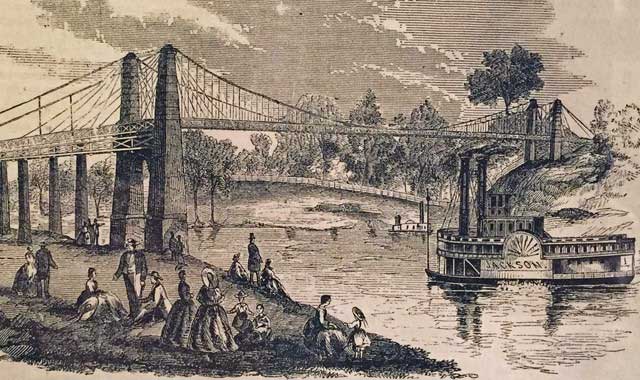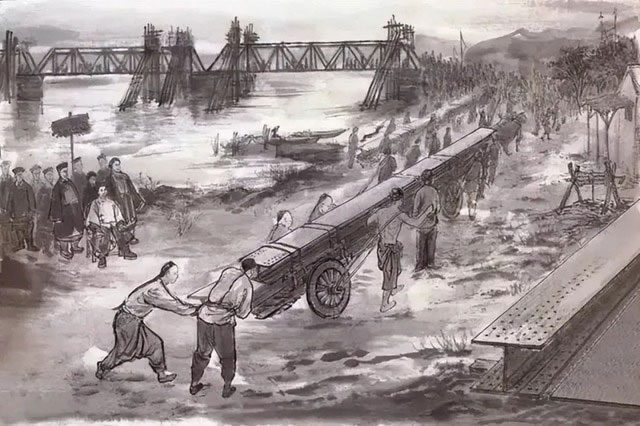In an era without modern technology and advanced tools, humanity faced rivers, canyons, and chasms that seemed insurmountable, yet they displayed unparalleled ingenuity and courage.
Suspension bridges are structures where the bridge deck is supported by steel cables hung from towers. They originated from the primitive masts of sailing ships. With advancements in science and technology, they gradually evolved into a common type of bridge in modern engineering.
The concept of suspension bridges can be traced back to the time of ancient sailing vessels. At that time, it was discovered that large trees could be erected to support the sails of ships, which served as the prototype for suspension bridges. Over time, humans refined and improved the design of suspension bridges to meet various needs. During the Middle Ages in Europe, the use of stone and wood began to take shape, leading to the construction of iconic suspension bridges, such as the “Vetorica Bridge” in Florence, Italy.
Hundreds of years ago, the process of building suspension bridges was arduous and challenging. Due to technological limitations of the time, designing and constructing a suspension bridge required highly skilled engineers along with a large workforce and resources. Engineers had to accurately calculate parameters such as tension, pressure, and load on each part of the bridge to ensure it was sturdy and safe.

A suspension bridge is an ancient and mystical structure, with construction principles rooted in the clever use of tension and pressure balancing. A century ago, engineers discovered this principle when faced with the challenge of crossing wide rivers or canyons, successfully applying it to the design and construction of suspension bridges. The construction of suspension bridges primarily relies on two main factors: the cables and the bridge deck. The cables are the tension-bearing elements connecting the towers to the bridge deck, which is the part that people traverse. During the construction of a suspension bridge, it is essential to ensure that the tension in the cables and the pressure on the bridge deck are balanced to maintain a stable crossing over water or chasms.
However, the groundbreaking development of suspension bridges truly began in the 19th century. Engineers started using chains and steel cables instead of traditional materials like wood and stone to construct larger and more complex suspension bridges. Subsequently, the design principles of suspension bridges were studied in greater depth. Engineers discovered that supporting the bridge deck with multiple steel cables hung from towers could enhance the stability and load-bearing capacity of the bridge.
As technology advanced, the design and construction of modern suspension bridges became increasingly sophisticated. For instance, the Golden Gate Bridge in San Francisco is one of the most famous suspension bridges in the world. Its design employs a main cable suspended from two large towers and side cables that support the bridge deck to ensure the bridge’s stability and safety. The structure of modern suspension bridges is also gradually evolving to be lighter and more efficient, utilizing new materials and design concepts to enhance the overall system’s flexibility and stability.
The principle of constructing suspension bridges a hundred years ago was to maintain the bridge’s stability by balancing the tension in the cables and the pressure on the bridge deck. Designing and constructing a suspension bridge requires engineers to consider various factors and implement appropriate measures to ensure the bridge’s durability and safety. Today, we can appreciate many beautiful and efficient suspension bridges that not only improve transportation conditions but also symbolize the pursuit of a better life.

Cables are made of high-strength materials such as steel wire or cable. When these cables are tensioned, they bear the weight of the bridge deck and pedestrians. The crucial role of the cables is to transfer the pressure from the bridge deck to the towers and distribute this pressure to the fixed anchor points on either side. By establishing the correct tension in the cables, we can equate the tension in the cables with the pressure on the bridge deck, achieving a state of balance.
Today, suspension bridges are widely used in modern engineering. They can not only span rivers and seas, connecting transportation between two regions, but also become landmarks of cities and tourist attractions. Various forms of suspension bridges are utilized in different transportation modes such as roadways, railways, and sidewalks, providing citizens with a convenient and comfortable commuting environment.
As a bridge structure originating from ship masts, suspension bridges have undergone a long history of development and technological advancement. From ancient wooden suspension bridges to modern steel suspension bridges, the design principles and engineering technologies of suspension bridges are continuously innovating and improving, providing significant support and assistance to people’s daily lives and economic development. In the future, with the relentless advancement of science and technology, suspension bridges will play an increasingly important role in many fields, creating a better future for humanity.

The pressure on the bridge deck is also a key factor in achieving balance in suspension bridges. When pedestrians or vehicles cross a suspension bridge, their weight exerts pressure on the bridge deck. To keep the suspension bridge stable, engineers need to ensure that the pressure on the bridge deck equals the tension in the cables. To achieve this, engineers design the durability of the bridge deck based on predicted load conditions to ensure it can support weight and maintain balance.


















































